Authentic and easy French Béarnaise sauce recipe, inspired from where it originated near Paris in 1837. Discover the difference between a Hollandaise sauce, what it goes with, plus the authentic recipe, its ingredients and history from France.
For those who have not made it because it feels to fussy to them or easy to get wrong, you have very helpfully broken down some of that mystique. Excellent.
Betty
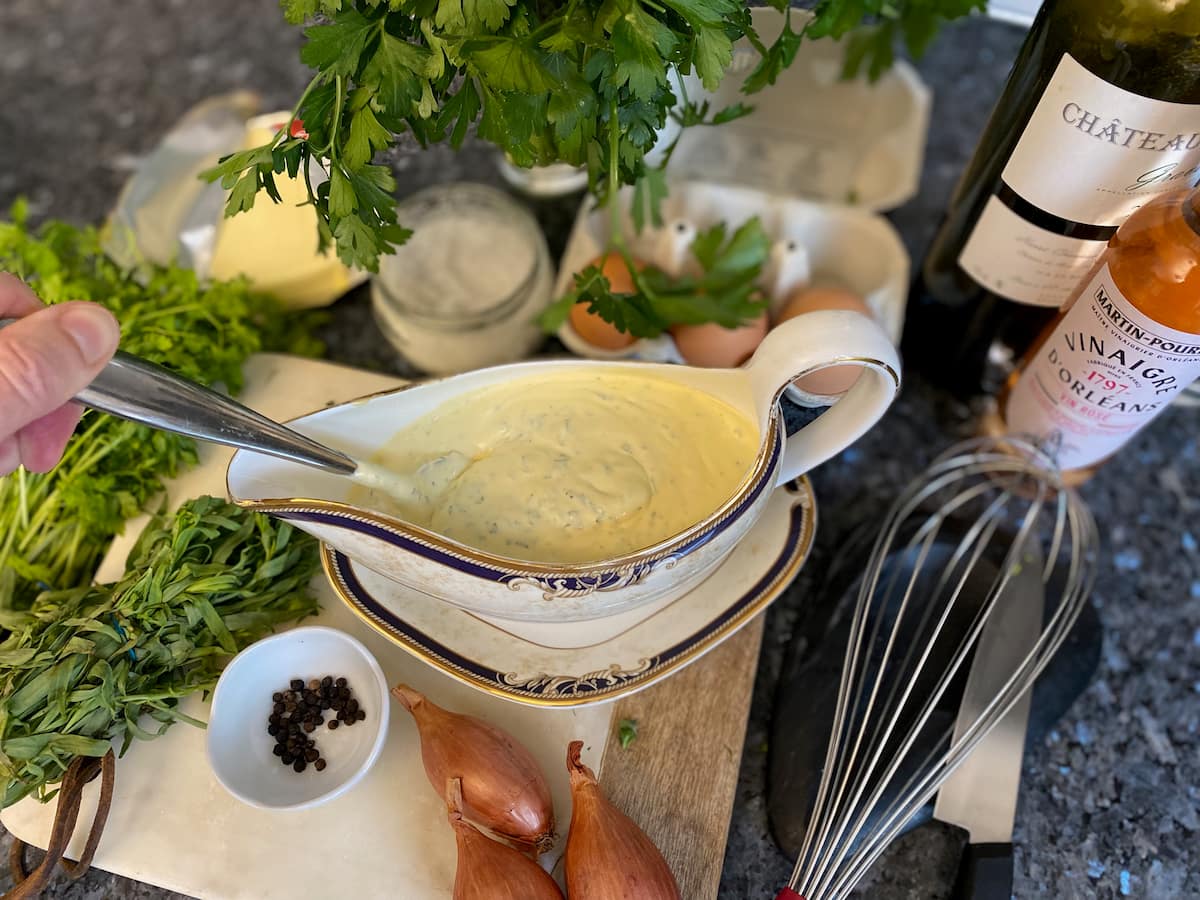
Homemade Béarnaise is So Much Better!
How many times have you seen the French classic Béarnaise Sauce on a menu and thought it was too difficult to make? Well, let me show you how easy the recipe is to whip up an authentic version at home. It also tastes 10 times better than the jarred stuff in supermarkets!
Why is It so Good?
The best Béarnaise sauce is made using quality ingredients.
By that I mean fresh, organic eggs and only fresh herbs. Although it's authentically made with clarified butter, this classic can be made with just good quality French style butter (82% fat).
Can't find fresh herbs? Freeze dried or dried can be used but the taste will not be at all the same. Please make it with fresh as much as you can, otherwise it won't be as good!
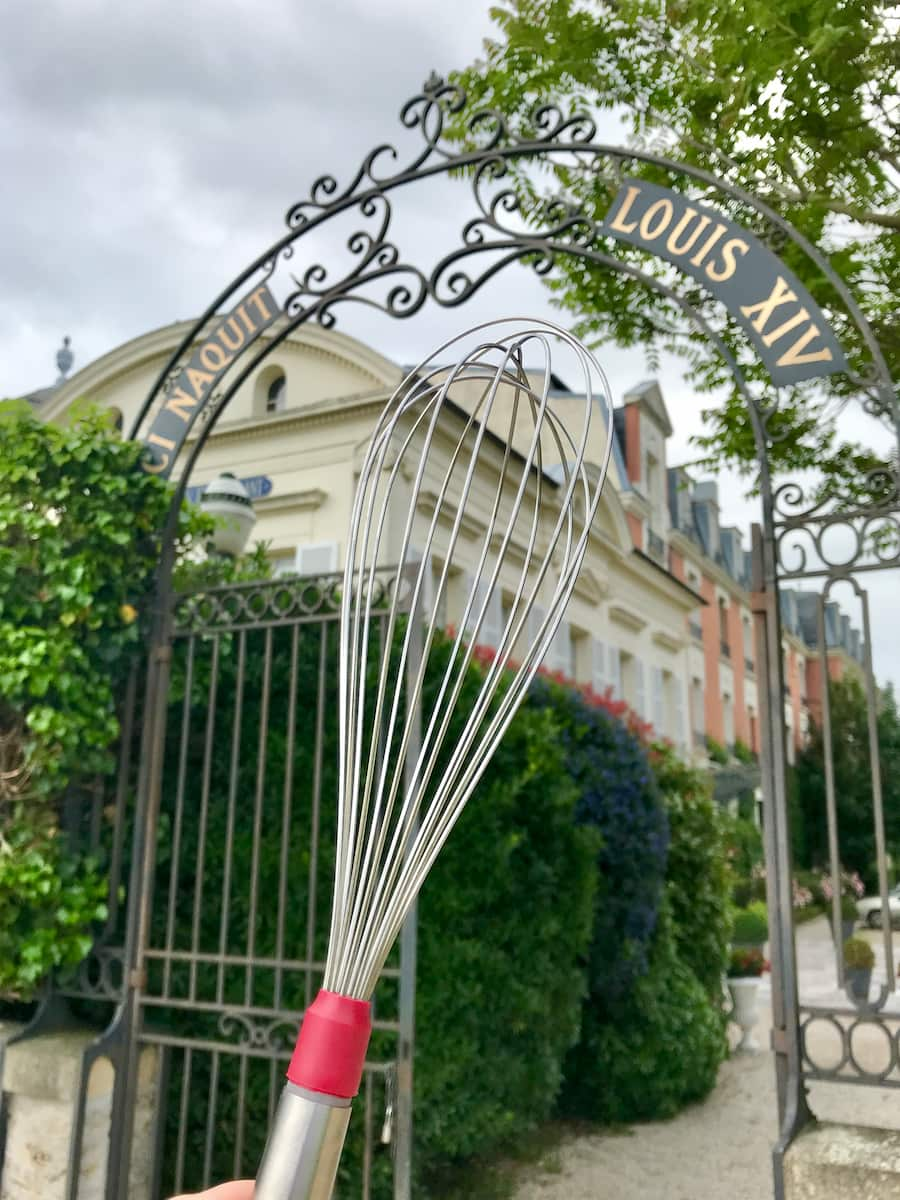
Where Does Béarnaise Sauce Come From?
Why the name, Béarnaise? It didn't come from the French Province of Béarn. Likewise, it has nothing to do with the French Béarnaise cows from the Pyrénées.
Instead, the sauce was born at Le Pavillon Henri IV, a hotel in Saint-Germain-en-Laye, just outside Paris, which was built over the original spot of the Château Neuf, where Louis XIV was also born in 1638.
For more history on this part, see my introduction to Saint-Germain-en-Laye.
In August 1837, for the inauguration of the Paris-St-Lazare to Le Pecq's steam train line, the Pavilion Henri IV was given the opening banquet. Head Chef Jean-Louis Françoise-Collinet was making a shallot reduction. As it went wrong, to correct it he added butter to make an emulsion.
In the end, he took the basic recipe for Sauce Hollandaise, replaced the lemon juice with white wine vinegar, shallots, chervil and tarragon and the Sauce Béarnaise was born.
Why is it Called Béarnaise?
Why did chef Collinet call it Béarnaise? The local story (from our tourist information guides) goes that he was first inspired by the name of the hotel, Henri IV. The hotel was King Henri IV's previous home at the Château Neuf long before it was a restaurant.
So, when he was asked by the clients what the sauce's name was, the Chef immediately took inspiration from the hotel's bust statue of Henri IV in the restaurant. As Henri IV came from the province of Béarn and known as Le Grand Béarnais, the chef named the sauce after him. Except la sauce is feminine, changing it to an 'e' on the end!
The chef also accidentally invented the soufflée potato (pommes soufflées) and served both of his creations at the opening. What a way to kick off a culinary event!
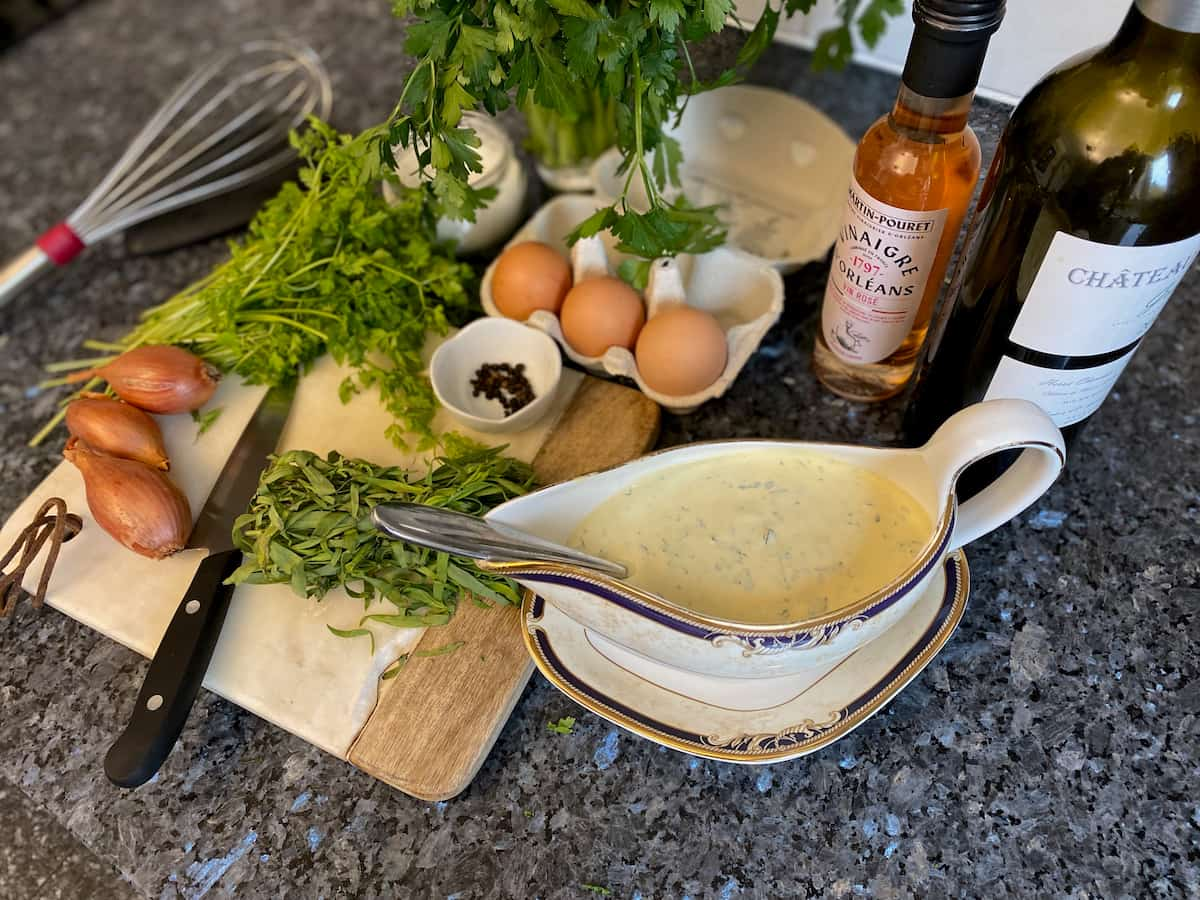
What is the Difference Between Béarnaise and Hollandaise Sauce?
In the 1800s, Chef Antonin Carême taught us that in French cuisine, there were four basic sauces - each called a "Mother Sauce".
Later, Auguste Escoffier took Câreme's rules of Haute Cuisine a step further by adding a basic fifth sauce. This fifth mother sauce, called Hollandaise was classed by Escoffier, even although it was created around the time of Louis XIV during the French war with Holland. So what is Hollandaise?
- Hollandaise sauce is a warmed emulsion of egg yolks, white vinegar, lemon juice, plus melted butter.
- Later, its most famous offspring, the Béarnaise sauce was born in Saint-Germain-en-Laye, just west of Paris.
It's known as a 'child' of the mother hollandaise sauce as it takes the sauce as a base. Like mother Hollandaise, child Béarnaise is also a warmed emulsion of egg yolks, white vinegar and melted butter - but instead of lemon juice, has added shallots and fresh aromatic herbs of tarragon and chervil.
No Lemon!
Many recipes mistakingly add mustard or spices (some even add Tabasco!) or herbs such as oregano. Please don't add any of them! Not only do they not belong in the ingredients, they change the flavour completely.
It's important to enjoy the taste of the fresh herbs and keep to the classic French sauce.
So an authentic Béarnaise does not contain lemon juice, cayenne pepper or Tabasco.
Replace the tarragon with mint and you have a Sauce Paloise.
What does Béarnaise Sauce Taste Like?
It has the same creaminess as the basic hollandaise but a subtle acidity from the vinegar. Béarnaise sauce's flavours are much richer and more pronounced than a classic mayonnaise or the hollandaise. This is from the fragrant addition of three ingredients:
- shallots
- fresh tarragon and
- chervil
The tarragon in particular lends a sweetness and aniseed or liquorice taste to the sauce. It's the tarragon and white wine vinegar that makes that fragrantly addictive acidity that we associate with the star of sauces with steaks.
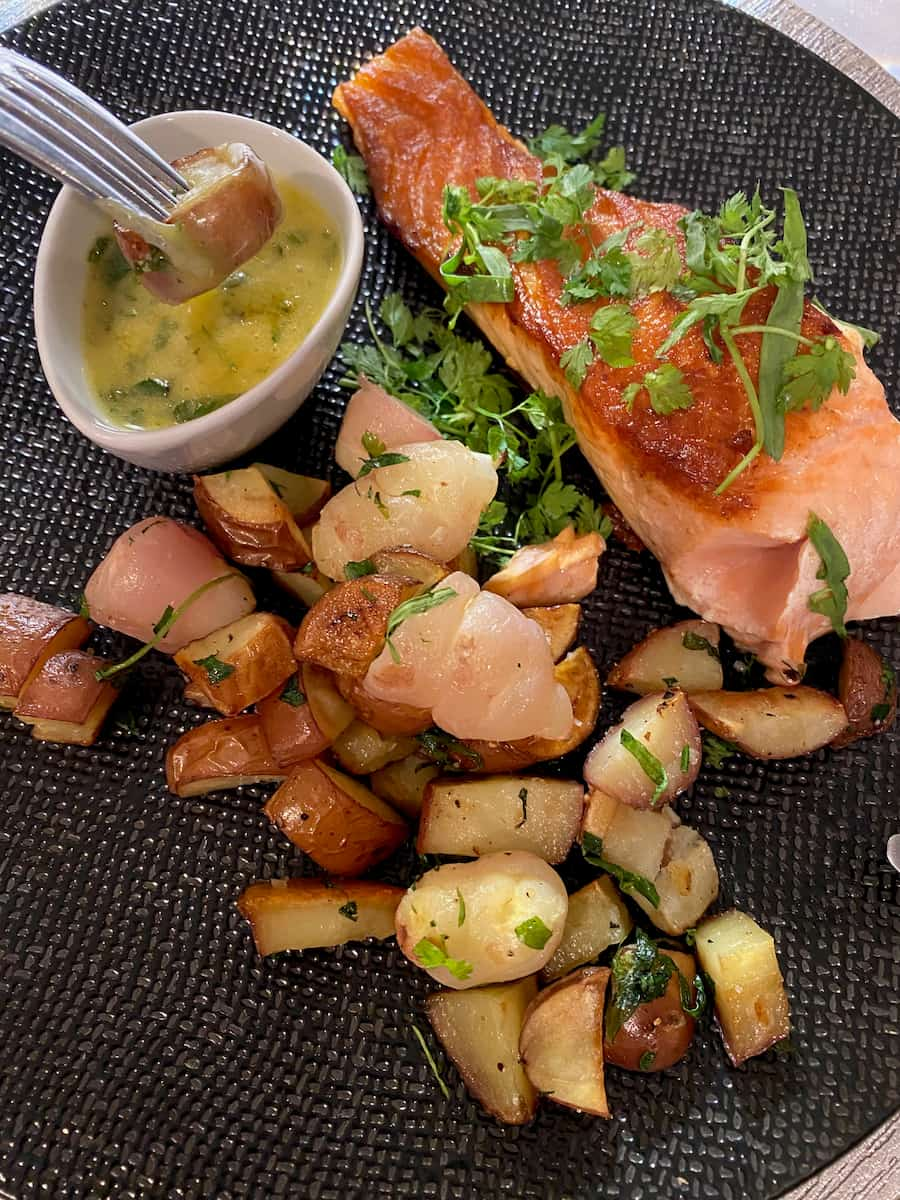
What Does Béarnaise Sauce Go With?
Traditionally in French cuisine, Béarnaise Sauce is best enjoyed served with meats and fish. It goes well with salmon, chargrilled steaks, chicken - even asparagus. It's also sheer luxury spooned on split, baked potatoes or chips (French fries).
Moreover, if you love Eggs Benedict, as poached eggs marry well with Hollandaise sauce, try Béarnaise with smoked salmon instead of ham - it's divine.

Béarnaise Sauce - Authentic Historical Ingredients
The hotel's executive chef, Patrick Käppler, has posted the Béarnaise Sauce recipe in French, published by the Hotel Pavillon Henri IV, without the actual quantities.
As you can see, to continue the sauce's tradition, the chef primarily makes it with the classic tarragon (estragon) herb - but also adds chervil (cerfeuil) and a little parsley (persil) added at the end of cooking.
Following my challenge from L'Office de Tourisme in les Yvelines, this Béarnaise Sauce recipe was also cited by literary giant, Dumas (père). Known best for The Count of Monte Cristo, Dumas was just as serious a gourmet and cook, with his pet masterpiece, the Grand Culinary Dictionary published 3 years after his death. For more, see my article, Monte Cristo and Alexandre Dumas' Love for Cuisine.
Dumas cites 'using a good vinegar from Orléans', uses oil instead of butter and parsley or tarragon:
Sauce échalote à la béarnaise.
Alexandre Dumas: Le Grand Dictionnaire de Cuisine (1873), under "Sauce".
Mettez dans une petite casserole deux cuillerées à bouche d'échalote hachée et quatre cuillerées de bon vinaigre d'Orléans ; la poser sur le feu et cuire les échalotes jusqu'à ce que le vinaigre soit réduit de moitié ; retirez alors la casserole, et quand l'appareil est à peu près refroidi, mêlez-lui quatorze jaunes d'oeufs, broyez-les à la cuiller et joignez-leur quatre cuillerées à bouche de bonne huile. Posez alors la casserole sur un feu doux ; liez la sauce en la tournant, retirez-la aussitôt qu'elle est à point, et lui incorporez encore un demi-verre d'huile, mais en l'alternant avec le jus d'un citron ; finir la sauce avec un peu d'estragon ou de persil haché et un peu de glace de viande.
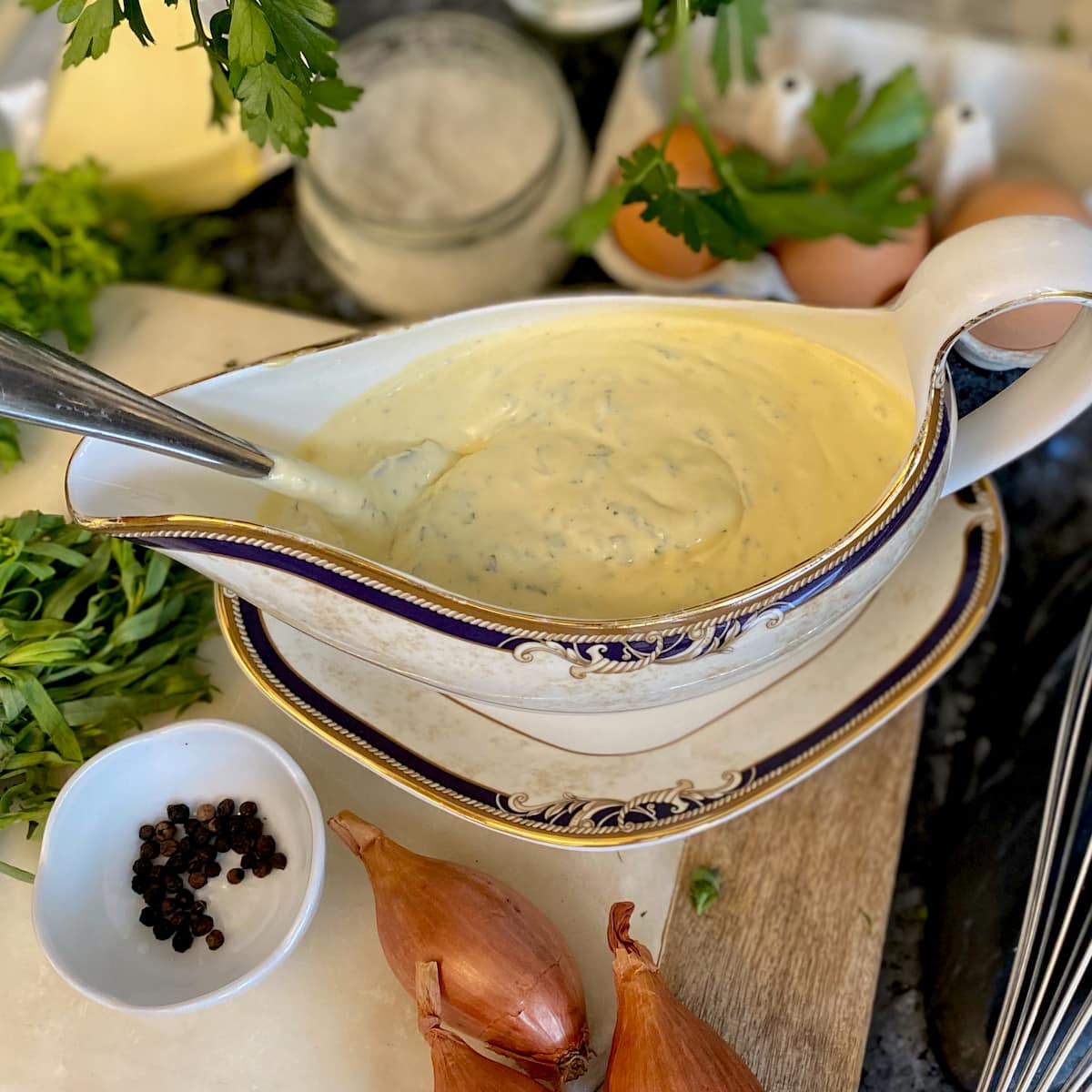
How to Make Béarnaise Sauce - Easy, Authentic Method
- Sauté the finely chopped shallots in a little bit of unsalted butter in a saucepan until translucent.
- Then add the white wine vinegar, white wine, tarragon stalks (not the leaves) and crushed pepper. Heat on medium until it boils, reduce the heat and leave to reduce for about 5 minutes until there's about 2-3 tablespoons.
- Filter the liquid using a sieve into a bowl then return to the saucepan (optional - or leave them in, just remove the tarragon stalks).
Tip: adding the herb leaves early on will kill the flavour - using tarragon stalks gives more flavour initially but the leaves are added later, along with the chervil.
For more, see the market page on fresh herbs.
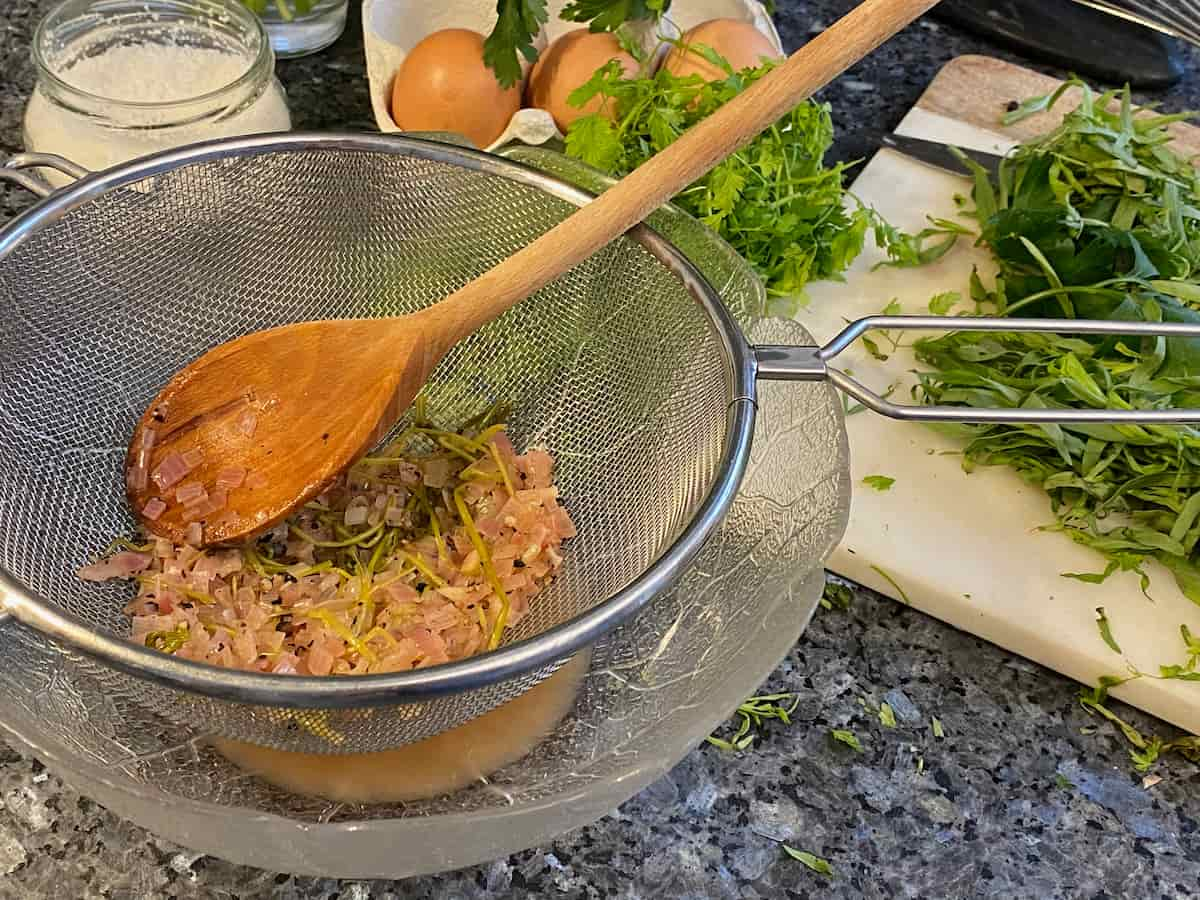
Easiest Way to Clarify Butter
Meanwhile, prepare the clarified butter. I don't bother filtering it or any fancy methods. Here's how:
- Melt gently in a saucepan over low heat until the creamy milky proteins rest at the bottom of the pan. Carefully pour the top golden butter into a glass, leaving the milky protein part behind. Set aside.
- If still a little creaminess in the glass, just pour the liquid golden butter very slowly into the sauce. The creamy part will be left at the bottom of the glass.
Tip:This step is optional, as adding butter is of course possible too. However, clarified butter is not only authentic but thickens the sauce better and more easily.
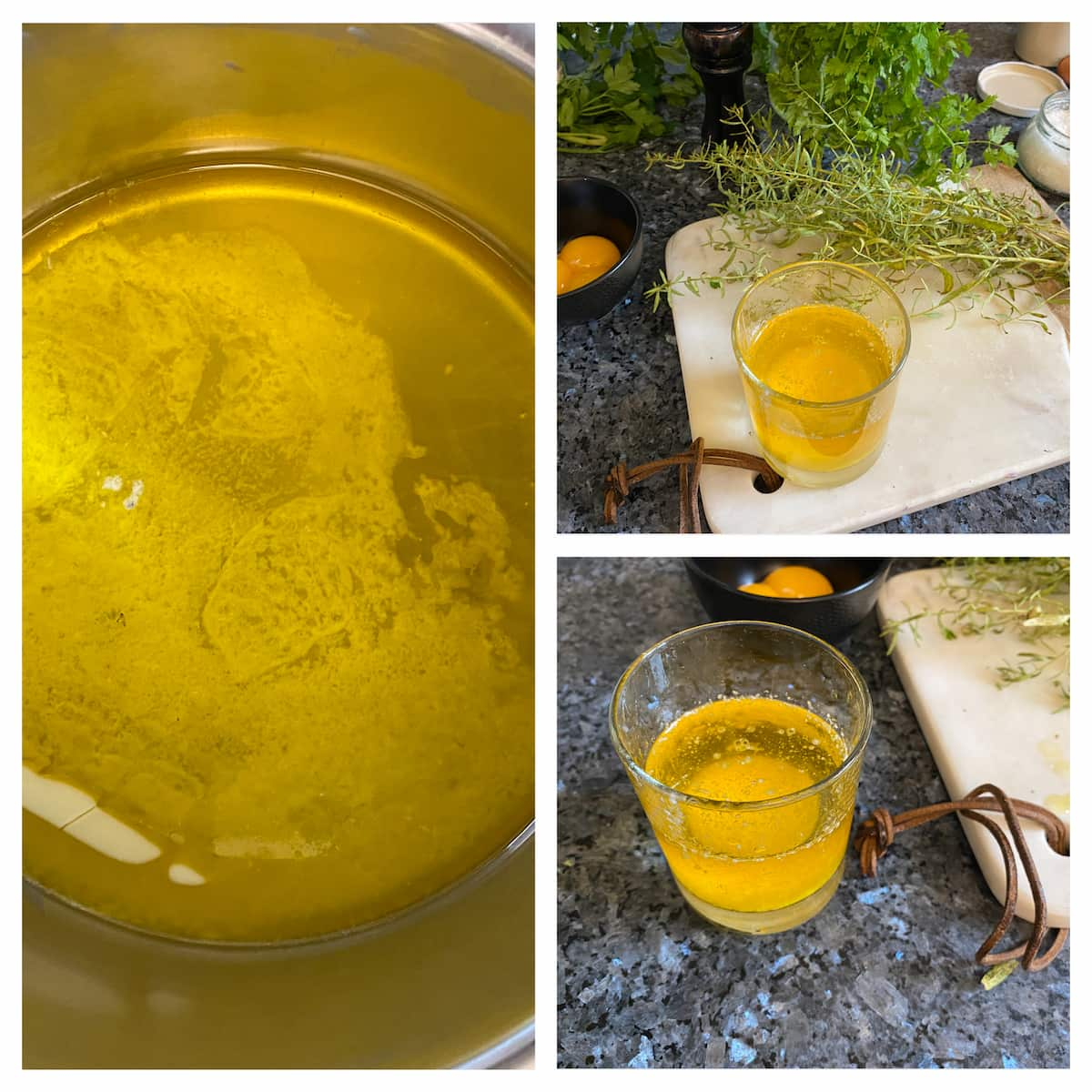
- Over a low heat, add the yolks and whisk constantly until mousse-like and it thickens slightly. The pan should not get too hot (able to touch the pan with bare hand) as the yolks should not be cooked/curdled. Take off the heat.
- Incorporate the warm, clarified butter and continue to whisk until thickened.
- Add the chopped fresh tarragon, chervil and parsley leaves. Season with salt to your taste.
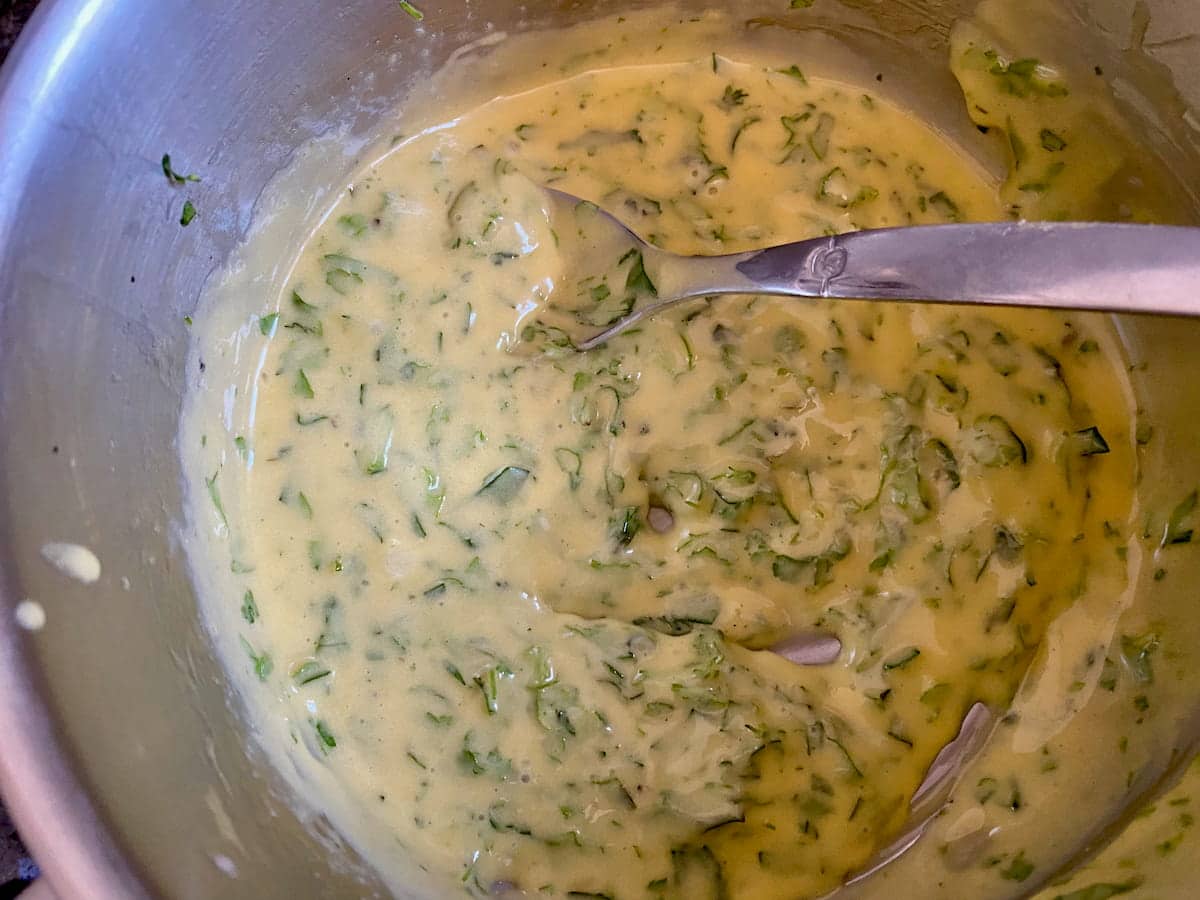
How to Reheat Béarnaise Sauce
Béarnaise sauce is best when made as close as possible to serving. Ideally I'm not a chef serving this in a restaurant so I don't have these kind of worries at home but I hear the best way to keep Béarnaise sauce without it splitting is by keeping it in a thermos.
Many chefs make this straight in the pan (just like Dumas describes above) and reheat it gently, directly in the pan. If you are afraid of making the sauce split (this doesn't happen if you follow the recipe to the letter), then reheat the sauce over a double boiler (whisk in a bowl over simmering water).
After trying both ways, it's so much easier to reheat directly in the saucepan - as long as it's over a very low heat. By that, the pan should be warm (not hot) to the touch.
Troubleshooting tip: if the sauce gets too hot and starts to split, take off the heat immediately and add a little warm water. Frankly, I've not had problems with the latter, as the recipe is so easy and as long as it's served reasonably quickly, the results are light and fluffy.
Once cooled, the sauce can keep in the fridge for 24 hours.
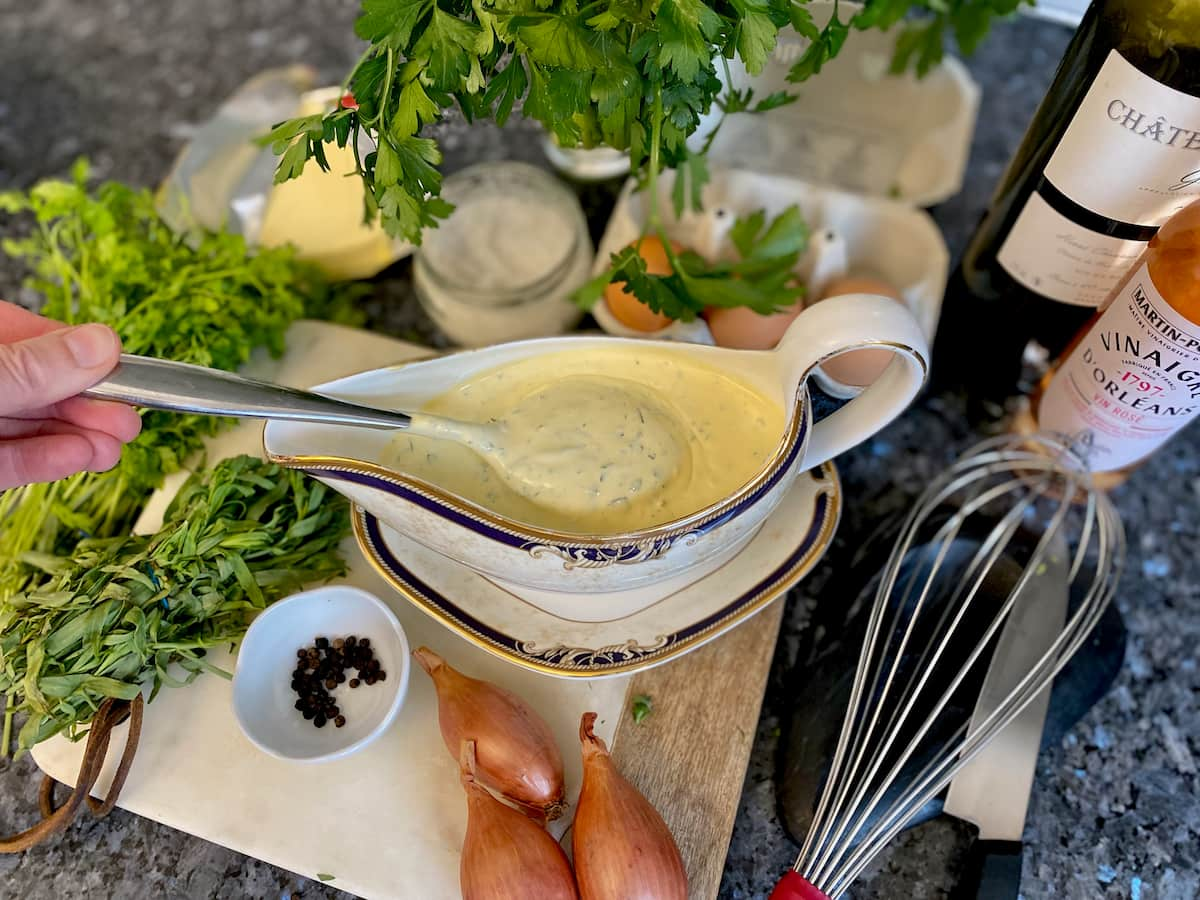
The simple Béarn-aise-sauce-ities of life
They'll come to you ... (I'm proud of that pun! Sing it with me)
Video upcoming from Saint-Germain-en-Laye.
Subscribe to my YouTube channel to be notified when it comes out.
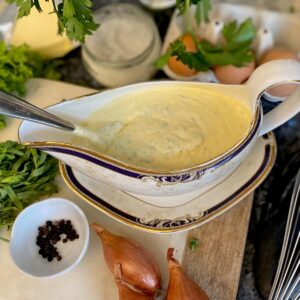
Béarnaise Sauce
Ingredients
- 3-4 small shallots chopped finely
- 50 ml (2floz/ ¼ cup) white wine vinegar
- 100 ml (3.5floz/ ⅖ cup) white wine
- 3 branches fresh tarragon stalks separated from leaves (chopped)
- 1 teaspoon black peppercorns crushed
- 3 egg yolks organic
- 125 g (4.5oz/ ½ cup) unsalted butter clarified (gently melted and separated from milk proteins)
- pinch fleur de sel salt (or Maldon, Celtic sea salt)
- 1 tablespoon fresh chervil finely chopped
- ½ tablespoon fresh parsley (flat-leaf) optional
Instructions
- Sauté the chopped shallots in a little butter in a saucepan over a medium heat. When translucent, add the white wine vinegar, white wine, tarragon stalks (not the leaves) and crushed pepper to a boil in a small saucepan. As soon as it boils, reduce the heat and leave to reduce for about 10 minutes until there's about 2-3 tablespoons. Filter the liquid using a sieve into a bowl then return to the saucepan (optional: remove stalks but keep in the shallots)
- Meanwhile, prepare the clarified butter (optional but authentic step). Melt gently in a saucepan over low heat until the creamy milky proteins rest at the bottom of the pan. Carefully pour the top golden butter into a glass, leaving the milky part behind. Set aside.
- Over a low heat, add the yolks and whisk constantly until mousse-like and it thickens slightly. The pan should not get too hot (able to touch the pan with bare hand) as eggs should not be cooked. Take off the heat.
- Continuing to whisk, incorporate the warm, clarified butter until thickened. Add the chopped tarragon, chervil and parsley at the end. Season with salt to taste.
Notes
If planning on making this much later in the day, prepare the sauce reduction in advance and only the rest of the ingredients. Keep at room temperature (off the heat) and when ready to serve, reheat by whisking in the pan over a very gentle heat. Measures: Please note that all my recipes are best made using digital kitchen scales in precise metric grams. Both ounces (and cups) are given as an approximate guide.
This recipe was first published 3 June 2019 but is now completely updated.
More About the Sauce's Birthplace
- Introduction to Saint-Germain-en-Laye;
- Take my online DIY chocolate and pastry tour of Saint-Germain-en-Laye;
- Self-Guided Tour of Saint-Germain-en-Laye, including a rooftop visit to the castle.



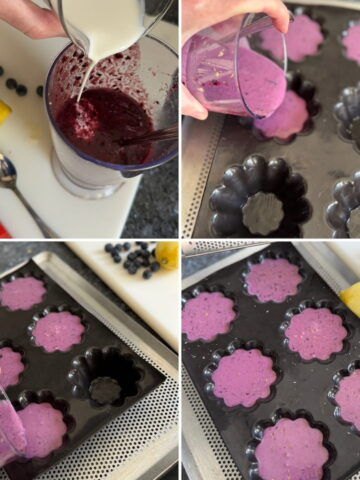


Lucie
This sauce is so good... and loved it with the potatoes. The pictures are making my mouth water.
Jill Colonna
The potatoes were happy to dive in too, I think! Thanks Lucie x
Christina
So interesting! Love the history behind all of the sauces, but especially Béarnaise! I don't believe I've ever tasted it, and know I've never made it, but sounds like my cup of tea! Will have to try it to check it off my culinary bucket list!
Jill Colonna
Well, I do believe we have the same sauce boat, plates and cups of tea to serve it in, too! Can't believe you've not tried it yet. Ever since I made this, I'm thinking of more things to serve it with!
Nico @ yumsome
Mmmm béarnaise with asparagus - Heaven on a plate! It's been far too long since I made this... my tummy is telling me I now need to remedy that!
Jill Colonna
Only too happy to inspire you back to the Béarnaise-eccities, Nico!
Sisley
This looks delicious. It's great to see how it looks when made fresh.
Jill Colonna
Thanks, Sisley. Once you've tasted it fresh like this, there's no return!
Carol Gillott
YUM Maybe next cookbook will be a historic Saint-Germain-en-Laye book?
Gorgeously detailed.
Jill Colonna
What a lovely idea, Carol. I'd only do it if you painted the endpapers, like you did so beautifully in my last book!
Thomasina
Great to know the origin of Bearnaise Sauce. For years and years to me it's just been a name for a sauce in a restaurant. Well worth trying when next we have steak. Also great to know that it freezes well.
Jill Colonna
I do hope you try it, Thomasina. You'll discover that this is so quick to whip up and so worth it on your next steaks!
Betty
Thank you for sharing this, Jill. The sauces like this are the classics for very good reasons, not the least of which is how many foods they make just that much better! For those who have not made it because it feels to fussy to them or easy to get wrong, you have very helpfully broken down some of that mystique. Excellent! How fun to know that something so classic was created where you are!
Jill Colonna
Thanks, Betty. I honestly thought this was a difficult sauce to make a few years ago until I finally tried it. It's ridiculously easy - and so blooming good! Glad you joined in my little saucy walkabout. Have a delicious weekend.
Choclette
As I'm not a steak eater, I didn't really have much idea about Bearnaise sauce. But now you've suggested asparagus and egg as accompaniments I'm all ears. It sounds delicious too. As it happens, I've just planted some tarragon and chervil and our parsley is growing well - all I need is time for it to grow. I adore tarragon, but it's virtually impossible to buy here. Lovely informative post too.
Jill Colonna
That's great that you've planted tarragon and chervil - great timing!
Forgot to mention that Béarnaise sauce is also yum with potatoes.
Jenny
What fascinating stuff! I love Bearnaise sauce especially on a good T-bone steak. Had no idea of the history behind it. Thanks so much for sharing this!
Jill Colonna
It's a pleasure to share the story, Jenny, especially as we can see the hotel from our home down in the Seine valley below. I have been meaning to post this for so long! Enjoy it with your next steak.